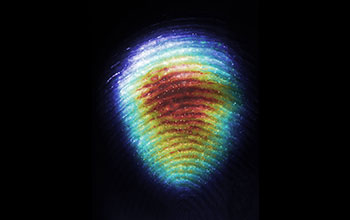Multimedia Gallery
Ultrasonic vibrations cause fingers to bounce on touchscreens
Researchers at Northwestern University have discovered why applying ultrasonic vibrations to a flat, featureless glass plate makes it feel slippery. In this image, warmer colors indicate areas where the vibration-induced air cushion is stronger.
More about this image
Haptics researchers have long known that applying ultrasonic vibrations to a flat, featureless glass plate makes it feel slippery. But they have also long debated why this occurs.
Now, J. Edward Colgate, a professor of mechanical engineering and the Allen K. and Johnnie Cordell Breed Senior Professor in Design, and his team at Northwestern University have discovered that the vibrations reduce friction by causing the fingertip to bounce on pockets of trapped air.
Colgate, a haptics technology pioneer, says understanding this underlying reason is extremely useful and will help researchers engineer more sophisticated devices that not only vary friction but do other things, such as exert forces on the finger.
The research was supported by the National Science Foundation (grant IIS 13-02422).
To learn more about this research, see the Northwestern University news story Mystery solved: The case of the slipping finger. (Date image taken: May 2016; date originally posted to NSF Multimedia Gallery: Dec. 16, 2016)
Credit: M. Wiertlewski/Center for High-rate Nanomanufacturing
Images and other media in the National Science Foundation Multimedia Gallery are available for use in print and electronic material by NSF employees, members of the media, university staff, teachers and the general public. All media in the gallery are intended for personal, educational and nonprofit/non-commercial use only.
Images credited to the National Science Foundation, a federal agency, are in the public domain. The images were created by employees of the United States Government as part of their official duties or prepared by contractors as "works for hire" for NSF. You may freely use NSF-credited images and, at your discretion, credit NSF with a "Courtesy: National Science Foundation" notation.
Additional information about general usage can be found in Conditions.
Also Available:
Download the high-resolution JPG version of the image. (635.8 KB)
Use your mouse to right-click (Mac users may need to Ctrl-click) the link above and choose the option that will save the file or target to your computer.



